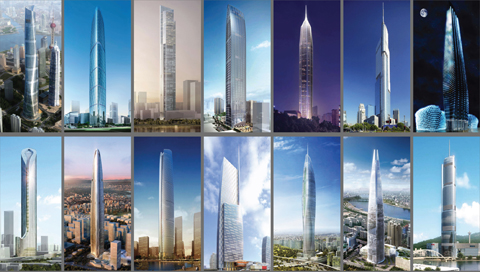The Skyscraper Museum is devoted to the study of high-rise building, past, present, and future. The Museum explores tall buildings as objects of design, products of technology, sites of construction, investments in real estate, and places of work and residence. This site will look better in a browser that supports web standards, but it is accessible to any browser or Internet device.
Defining Supertall
SUPERTALLS are a special class of skyscraper. More expensive to build than shorter structures, they require special wind-tunnel and seismic analysis, stiffer frames, extra material and special elevators, and often refuge floors or other safety measures.� At 80, 100, or, to date, up to 160 stories, supertalls create a special identity and status that can increase to value of their extra floors of valuable space.

20th-Century Supertalls �
In 1931, the Empire State Building became the tallest building in the world at 1250 feet / 381 meters to the tip of its ornamental mooring mast. It reigned until 1971, when the first of the twin towers of the World Trade Center topped out. The tallest and largest buildings of their age, WTC and Chicago's Sears Tower culminated the century-long evolution of the skyscraper-which was, typically, an office building, constructed of steel, in the United States. �
Supertalls were rare in the 20th century. Although many were proposed by architects and developers, the only four constructed until 1996 were the American four: the Empire State, the WTC Twin Towers, and the Sears Tower. The first international supertalls were completed in China: Shun Hing Square in Shenzhen and CITIC Plaza in Guangzhou, both office buildings. In 1998, the twin Petronas Towers were completed in Kuala Lumpur, moving the locus of "world's tallest building" outside the U.S. The last of the giants completed in the 20th century was Shanghai's Jin Mao Tower, which in its slender form, mixed-use program of offices and hotel, and concrete structure prefigured the typical 21st-century supertall.

21st-Century Supertalls
In the early 2000s, the new territory of supertalls became Asia and the Middle East, with development first focused in the major cities of Hong Kong and Shanghai, as well as in the super-heated residential real estate markets of Dubai. Since 2007, many second- and third-tier Chinese cities with populations of four to twelve million, such as Chongqing, Dalian, Guangzhou, Nanjing, Shenzhen, Tianjin, and Wuhan have announced major towers. China (including Hong Kong) accounts for 22 of the 48 projects in the exhibition.
As the Chinese supertalls illustrate, these towers share characteristics that define the new paradigm. They are simple, slender forms that taper toward the top, where floor-plates are reduced in size and depth for hotel for residential floors. Glass is the material of the new towers with only a few exceptions. Insulated glass units, energy efficient and quick to install, realize the modern fascination with crystalline towers. In their programs, they are mostly mixed-use, with offices on the lower floors and residences and hotels above. Most contain entertainment and communal spaces on the top stories and often in zones throughout the structure.
